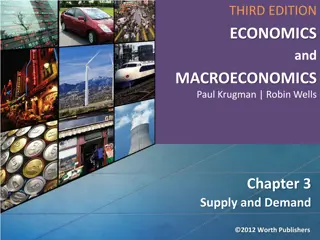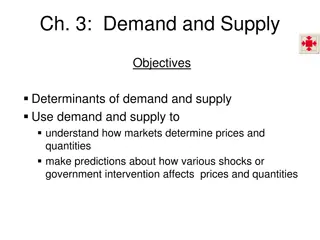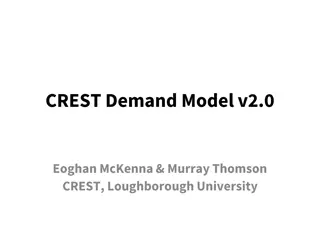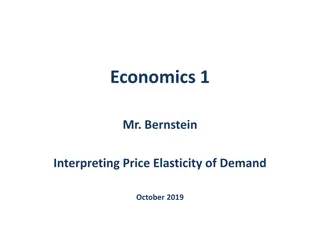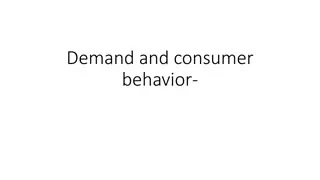
Importance of Time of Use and Demand Metering in Energy Consumption
Learn about the significance of time of use and demand metering in the energy sector. Discover why measuring power and energy consumption is crucial, the principles of demand metering, and why understanding demand is vital for utilities to recover costs and allocate service equitably.
Download Presentation

Please find below an Image/Link to download the presentation.
The content on the website is provided AS IS for your information and personal use only. It may not be sold, licensed, or shared on other websites without obtaining consent from the author. If you encounter any issues during the download, it is possible that the publisher has removed the file from their server.
You are allowed to download the files provided on this website for personal or commercial use, subject to the condition that they are used lawfully. All files are the property of their respective owners.
The content on the website is provided AS IS for your information and personal use only. It may not be sold, licensed, or shared on other websites without obtaining consent from the author.
E N D
Presentation Transcript
TIME OF USE AND DEMAND METERING - WHY THEY ARE IMPORTANT July 24, 2024 8:45 AM -- 10:15 AM Carl Chermak
ELECTRIC POWER AND ENERGY Power (P) Rate at which energy is produced or consumed Measured in Watts or kW* At any single point in time, P = V x I Energy (W, for Work) Summation of power applied over time Measured in Watthours or kWh* tescometering.com 2
ELECTRIC POWERAND ENERGY Poweris like your car s rate of speed as shown on the speedometer. Energyis like your car s traveled distance as shown on the odometer. 80972 tescometering.com 3
MEASURING WHATIS DELIVERED Delivered Item Gasoline Units of Delivery Gallons Units for Rate of Delivery Gallons/Hr Natural Gas Cubic feet Cubic feet/Hr Water Gallons Gallons/Hr Electricity Watt-hours Watts tescometering.com 4
PRINCIPLESOF DEMAND METERING Whatis Demand ? The average value of power (or related quantity) over a specified period of time Expressed in units of: kilowatts (kW) kilovolt-amperes (kVA) kilovars (kvar) amperes (A) Or other suitable units tescometering.com 5
WHY IS DEMAND IMPORTANT? Heavier loads tax the utility system more than smaller loads, and require larger equipment for generation, transmission, and distribution Utilities must recover for the costs of the infrastructure necessary to support the larger loads Demand is a measure of the impact of a consumer s loads Demand is used to determine how much a consumer should share in paying for infrastructure tescometering.com 6
WHY IS DEMAND IMPORTANT? More equitably allocates the cost of service to users Provides information on unexpected customer load growth kW demand is relatively easy to measure and record tescometering.com 7
DEMANDAND COST RECOVERY Utilities meter for Energy Consumption (kWh) in order to recover for cost of fuel. For larger, typically C&I customers, utilities also meter for Peak Demand in order to recover for cost of infrastructure. tescometering.com 8
VOCABULARY Power: The rate at which energy is being used (watts) Energy: The total use of power over a period over time (watt hours) Demand: The average value of power (or related quantity) over a specified period of time. Demand Interval: The length of the interval of time upon which the demand measurement is based. Block Demand: Demand calculation based on a single demand interval. Rolling Demand: Demand calculation based on several demand sub-intervals. tescometering.com 9
VOCABULARY (Cont) Maximum Demand: The largest of a particular type of demand occurring within a specified period, such as one month. Also called peak demand. Cumulative Demand: The sum of the previous billing period maximum demand readings. At time of billing period reset, the maximum demand for the most recent billing period is added to the previously accumulated total of all maximum demands. Continuously Cumulative Demand: The sum of the previous billing period maximum demands (cumulative demand), and the present period maximum demand. tescometering.com 10
HOW DO WE MEASURE FOR DEMAND? Demand is the average power calculated for every demand interval, simply Energy / Time. Example: For 10 kWh consumed in a 15-minute demand interval, Demand = 10 kWh / 0.25 h Demand = 40 kW A watthour-demand meter keeps a record of the Peak Demand since the last demand reset, and this is used for billing. tescometering.com 11
BLOCK DEMAND 300 kW Instantaneous Power Demand Demand Demand Demand 200 kW 100 kW Energy is equal to the area under this power curve 15 min 15 min 15 min 15 min demand reset Energy: 48 kWh 46 kWh 47 kWh 50 kWh Demand: 192 kW 184 kW 188 kW 200 kW (peak)
ROLLING DEMAND 300 kW Instantaneous Power 200 kW 100 kW 5 5 5 5 5 5 5 5 5 5 5 5 min min min min min min min min min min min min 200 kW 192 kW 184 kW 188 kW 215 kW 145 kW 223 kW 208 kW 150kW 238 kW (peak) demand reset
PEAKAND CUMULATIVE DEMAND Cumulative Demand Continuously Updated Peak Demand Cumulative Demand Interval Demand T O T A L R E S E T 0 0 0 0 0 0 0 1 2 3 4 40 42 50 47 40 42 50 50 40 42 50 50 D E M A N D R E S E T 0 50 50 50 50 50 50 97 97 97 99 1 2 3 4 47 44 41 49 47 47 47 49 D E M A N D R E S E T 0 99 99 99 99 99 99 142 145 145 145 1 2 3 4 43 46 44 45 43 46 46 46 D E M A N D R E S E T 0 145 145 tescometering.com 14
WHATIS LOAD PROFILE? Load Profile Data is a collection of discrete time interval metering data (kWh, kVAh, V2h, etc.) recorded for each channel in a meter over a user-defined period of time. Load Profile parameters have to be defined for every account. The parameters in specific may be: Interval size in time units* Interval length, i.e. number of such intervals* Channel unit of measurement* TOU (time-of-use) Calendar name TOU Schedule name tescometering.com 15
TIMEOF USE (TOU) Large utilities generate power from a variety of sources Fuel costs are very low for some types of plants, higher for others Very large and efficient base-load plants (the newest coal or nuclear plants) may have very low fuel cost. These also run 24 hours per day and every day possible Some old or less efficient plants are run only when the need is great, perhaps for only a few hours each day Some plants with very high fuel cost may be run only in emergencies tescometering.com 16
TIMEOF USE (TOU) The result: Varying energy cost as overall demand varies according to hour, type of day, and season So, a utility may offer lower pricing during off- peak periods when the energy is less costly, and impose higher pricing during on-peak periods when more costly plants must be run. This is known as TOU Billing. tescometering.com 17
TIMEOF USE (TOU) 1. TOU Billing more fairly allocates for the varying energy costs. 2. Consumers are incentivized to reschedule their loads. Utilities often assist consumers with tools to predict billing outcomes. The resulting schedule changes can drive an overall flatter load curve, decreasing the dependence on the higher cost power plants. OK, so how do we meter for that? tescometering.com 18
TIMEOF USE METERING A TOU meter accumulates energy, calculates demand and registers the data into specific rate buckets depending on the time of day TOU rate periods are typically called Peak, Shoulder Peak, Off Peak Different days of the week and holidays may have different TOU rate schedules You can have different Seasons TOU metering requires the meter to keep time and programmable dates are stored in calendars Meter can be programmed for self reads or demand resets on specific dates tescometering.com 19
T-76 REGISTER What did a TOU meter look like back in the day? tescometering.com 20
TOU AND DEMAND METERING Thank you Carl Chermak 315-436-8696 tescometering.com 21









